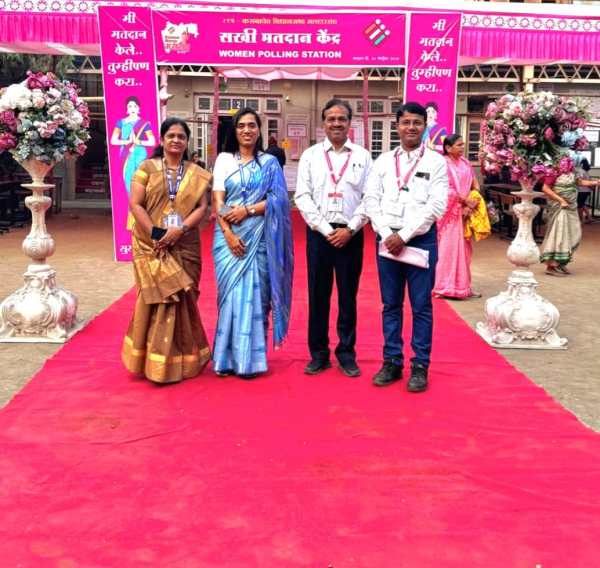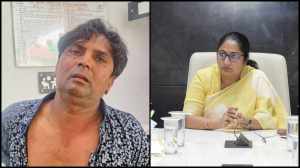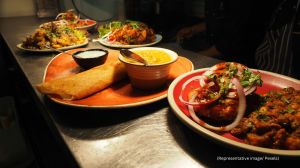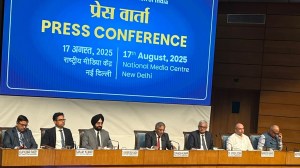Hindutva, farmer woes, govt schemes — key issues at play in Maharashtra Assembly polls
The BJP was the largest party in 2014 and 2019 assembly polls, winning 122 seats and 105 seats, respectively. In the Lok Sabha, the Congress regained ground to a great extent and is likely to hold its gains and consolidate further.
 Ajit Pawar after voting in Baramati on Wednesday. (Express photo by Arul Horizon)
Ajit Pawar after voting in Baramati on Wednesday. (Express photo by Arul Horizon)As Maharashtra votes on Wednesday for 288 seats across the five regions of Vidarbha, Marathwada, North and Western Maharashtra and Konkan, a glance at key issues that promise to determine the electoral outcome of the Mahayuti and MVA shows that while the former lagged significantly behind the latter in the Lok Sabha polls, the Mahayuti seems to have narrowed its gap to create a contest that is set to go down to the wires.
From Hindutva to hard Hindutva, the BJP took a giant leap to reinforce its distinct identity with a two-pronged strategy to not only galvanise its own right wing organisations affiliated to RSS, but also aimed at cementing cracks between diverse Hindus communities that were highly polarised on emotive issues like Maratha reservation, backward classes and entitled classes and fragmentation of 353 castes/communities under OBC.
Prime Minister Narendra Modi’s “ek hain toh safe hain” to Uttar Pradesh Chief Minister Yogi Adityanath’s “batenge toh katenge” was part of an orchestrated plan to weave all communities into one major Hindu block. While individuals take pride in identifying themselves as Hindus, BJP’s shrill campaign with overtones against Muslims does not seem to have enthused either rural or urban voters. A resident of Shivaji Nagar, Hemraj Lonar dismissed these provocative campaign as , “madari ke khel, implying that just as a human trainer tames a monkey to dance to hi drumbeats, netas come out with rhetoric to engage people. Some get fooled and others know it is just a trick.”
Hindutva in varying degrees has remained a common factor in the Lok Sabha and Assembly polls. In the Lok Sabha polls, the BJP and its alliance partner Shinde Sena had believed that the Ayodhya Ram Mandir, which was inaugurated by Modi on January 22, would help them emerge victorious in the elections to 48 seats. So when Mahayuti got 17 seats with the BJP getting only nine, it came as a rude shock to the party.
 MVA Baramati candidate Yugendra Pawar with his sister and parents during voting at the Katewadi polling center on Wednesday. (Express photo by Arul Horizon)
MVA Baramati candidate Yugendra Pawar with his sister and parents during voting at the Katewadi polling center on Wednesday. (Express photo by Arul Horizon)
Despite the dismal traction in Lok Sabha, BJP went back to Hindutva with a greater resolve to polarise as well as unite people. In this, it ensured a stronger partnership with RSS. According to Sangeeta Ramteke, a real estate agent based in Nagpur, “When Hindutva is used to dominate everything else, it is bound to boomerang. At Samvidhan Chowk ( Nagpur), leaders made a beeline to garland Dr B R Ambedkar’s portrait. When BJP followers in their overzealousness chanted Jai Shree Ram, others (non-BJP/RSS sections) wonder why not Jai Bhim. Instead of oneness, the Hindu unity objective gets defeated when you mix politics with religion. Its adverse impact leads to greater consolidation of voters not just amongst Muslims but dalits too.”
Unlike the Lok Sabha polls, the decibel on threat to the Constitution is lower in the Assembly polls. The MVA has reaped the benefits of “samvidhan khatre mein hai” in Lok Sabha by bagging 31 out of 48 seats. In Assembly, dalits no longer question the threat to the Constitution. What has upset some though is that the communal divide goes against the letter and spirit of the Constitution.
A dalit Aurangabad based contractor, Gautam Dongardive, said, “Why is Dr B R Ambedkar projected as a leader of dalits alone? Irrespective of party lines and leaders, anyone who does politics based on caste and religious lines clearly are in violation of the Indian Constitution. Unfortunately, society at large remains silent. The Constitution is being politicised and equated to dalits.”
Dalits, who constitute 10.8 per cent of the state population, are in sizeable pockets across state. There are 54 reserved seats — 29 scheduled castes, 25 scheduled tribes. Dalit Indian Chamber of Commerce and Industry (DICCI) chairman Milind Kamble said, “During Modi’s regime, the paradigm shift is one of patronage to partnership. Schemes like Stand Up India, Start Up and Mudra loans are all affirmative measures for the economic empowerment of dalits through self-reliance. The policy making it mandatory to procure four percent goods from dalits entrepreneurs is showing positive results.”
Another overarching factor driving this election especially in the Marathwada region is Maratha reservation. Activist Manoj Jarange Patil’s flip flop politics on reservation is targeted against the BJP. Insiders indicated MVA hopes to derive maximum benefit from anti-Maratha sentiments against the BJP in the drought prone Marathwada, which has 46 seats. Vidarbha with 62 seats is a battle between Congress and BJP for upmanship and also a change of power in Maharashtra. Here the OBC plank is central. How each party manages the micro OBC vote bank will decide the outcome.
 RBI Governor Shaktikanta Das casts his vote. (Express Photo by Ganesh Shirsekar)
RBI Governor Shaktikanta Das casts his vote. (Express Photo by Ganesh Shirsekar)
Across the rural belt, farmers’ unrest was a constant. Almost at par with that witnessed during the Lok Sabha polls. Despite bold interventions and plenty of promises in poll manifestos, a number of farmers voiced their anger and disappointment over the fall in prices. Farmers of soybean and cotton, which are the main crops in Marathwada and Vidarbha, complained their produce fetched lower rates. While soyabean fetched Rs 3,500 to 4,000 per quintal as against the MSP of Rs 4892 per quintal, cotton was Rs 5,500 to 7,000 instead of the MSP of Rs 7,100 per quintal.
According to farmer leader Vijay Jawandia, “The situation in the agriculture sector has not seen any improvement between the Lok Sabha and Assembly polls. The incentives to farmers become redundant when you cannot provide them higher remuneration for post harvest crops. They are pushed into vicious debt cycles and suicide.”
The Muslims consolidation against BJP led Mahayuti is a reality in Assembly polls. In the Lok Sabha polls Muslim organisations took a unanimous decision not to vote for Mahayuti and their political position remains the same. Constituting 11.56 per cent (1.3 crore) of the state’s population, Muslims play a decisive role in at least 38 constituencies with the vote share as high as 33.1 per cent to 78.4 per cent. The Congress in its manifesto has promised reservation to Muslims if voted to power. State BJP chief Chandrashekhar Bawankule said, “The Congress has always used Muslims as a vote bank. Whereas, BJP’s inclusive politics ensured the Muslim community’s mainstream development.”
The Shinde government’s Ladki Bahin Yojna, promising Rs 1,500 monthly allowance to women, will be put to the test in the Assembly polls. With 2.22 crore out of 4.6 crore women voters being beneficiaries of the scheme, the Assembly polls will see to what extent the scheme has changed the electoral outcome. Sangeeta Sayamkar, a villager from Borgaon ( Wardha), said, “I have received a total amount of Rs 7,500, as promised in Ladki Bahin Yojna. But them I have incurred huge losses in soyabean production.. I had to sell eight quintal soyabean at Rs 3500 a quintal.”
 Smt. Supriya Kadam Deshmukh, Smt. Sneha Waghchaure, Shri Suhas Jadhav, and Shri Sharad Phalke (AMF Team 215, Kasba Peth, Pune) at Ahilyadevi Girls’ High School, Pink Woman Polling Booth. (Photo: Election Commission of India)
Smt. Supriya Kadam Deshmukh, Smt. Sneha Waghchaure, Shri Suhas Jadhav, and Shri Sharad Phalke (AMF Team 215, Kasba Peth, Pune) at Ahilyadevi Girls’ High School, Pink Woman Polling Booth. (Photo: Election Commission of India)
The hue and cry over inflation and GST across rural and urban Maharashtra is a factor which resonated even during Lok Sabha polls. Apart from the hardened Hindutva line and Ladki Bahin Yojna, a majority of the issues which played a critical role in the Lok Sabha elections are at play in the Assembly polls too, albeit in varying degrees. Officially, both Mahayuti and MVA’s top leaders execute confidence they will form the government.
As NCP (SP) leader Sharad Pawar predicted, “MVA will cross the halfway mark to comfortably form the government. The Deputy CM Devendra Fadnavis is equally confident Mahayuti will cross the half-way mark and form government. The magic figure is 145 out of 288 seats.”
With a large number of rebels in the fray and a number of consulates in each constituency, Independents and rebels are in the reckoning in at least 30 to 35 seats. The rebel/independent was a non issue in Lok Sabha. Politically, the Assembly polls will be a measure of both factions of the NCP and Shiv Sena’s prowess. In the regions mentioned here, the parties splitting into factions are more acceptable to the masses. Whether the BJP, which is contesting 148 seats, is able to emerge as the single largest party for a third time will depend on how voting takes place.
In the last two elections in 2014 and 2019, the BJP was the largest party, winning 122 seats and 105 seats respectively. In the Lok Sabha, the Congress regained ground to a great extent. From the ground reality, it is evident Congress is likely to hold its gains and consolidate further. With 102 seats, Congress also vies for a leadership position within the MVA and in the state.







